Dr. Utr. Iur.
Frank
Van den Broeke
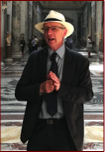
To book an authorised guided tour with me: .... Click here
Wine & Dine: ... Click here
Where to buy your tickets ... ? Click here
Pinacoteca/Art Gallery
Introduction
I like the pinacoteca. The way of conducting you through will be again with Plato & Aristotle, as explained in the introduction of the Vatican Museums. Sometimes paintings wants to show you an idealized world (Plato), in other moments they come much down to earth (Aristotle)
Whoever comes for the first time in Italy, is confused: What is made before what in the timeline of the history. The pinacoteca of the Vatican helps us. The rooms are built in a chronological order. I will apply subsequentely the Color Scheme of the rainbow in my text-boxes. Like the colors are changing, were going up in time ... We start in 1300, just before the popes left for Avignon, France.

"Painting is just another way of keeping a diary" said Pablo Picasso. And indeed, there are some different approaches for the Pinacoteca of the Vatican. For me, as much is the artistic value of the works exposed, the man and his time who made it, is as important. While since the time of the Illumination in the 18th Century, paintings became more and more the expression of the personal mood and feelings of the painter, until then, a painter worked on commission. His style could be innovative, but the message was bounded by the commisioner. We will see how painters like Caravaggio have to alter their work, or expressing the mind of the political and social order of their time. But artist are often ahead, announcing changes in the social and political order.
This article will not be concentrated on the tecnics used, but the red line through the Pinacoteca/Art gallery will be the mind of who commisioned the works as Propagation of Faith and the political and social world that surrounded the artists. How far went those influences ?
The collection was originally situated in the gallery of the Tapistery. One of the reasons why the vault of that gallery is not elaborated like the other galleries, but over the years the space wasn't enough anymore. So, a brand new wing was added to the Museums and inaugurated on the 27 October 1932 by pope Pius XI. "The idea of an art gallery, understood in the modern sense as an exhibition open to the public, was only born in 1817 after the fall of Napoleon and the consequent return to the Church State of a large part of the works belonging to it, according to the directions of the Congress of Vienna." (quote of the Vatican Museums)
In the entrance hall, is the bust of Pius XI and a cast of the Pietà of Michelangelo. Made in 1500 for the French Chapel of the old Saint Peter; the importance of the Transubstantion, dogma of immaculate conception 1854; was hit in head and hand in 1972. Now behind a protective glass in the Basilica.

Pius XI
Room 1-2
The Primitives of 12-14th Century
The political situation was quite fragile. The City States in Flanders fields and in Italy gained power day after day, menacing the social order of the feudal era. The air of the city made the people free. People after returning of the Crusades became free, and wanted to escape the old feudal system- a world divided in three classes: the working class, the nobility & the army and on top the clerus.
The upper classes had of course all interests in a status quo. Very often we see that also in the works of art, and the famous triptych of Stefaneschi shows you.

King Henry I's dream, John Worcester in The Chronicon ex chronicis
Triptych of Stefaneschi by Giotto di Bondone 1300 - room 2
Cardinal Jacobo Caetani degli Stefaneschi commisioned it in 1315. The Triptych (painting on three panels) was made for the old St. Peter's Basilica and could be viewed by the ecclesiastical hierarchy (priests) and the faithful. It devided the clery from the congregation, the so-called iconostasis in the orthodox churches . The popes just left Rome towards Avignon/France for the next 80 years. The battle between the baronies in Rome became day after day more feroucious, and the pope (from French origin) decided to avoid this battle by moving to Avignon.
In the centre part we have St. Peter, giving the blessing to .... Yes, cardinal Stefaneschi, who offers a miniature of the whole work of Giotto to St. Peter.
The action in the painting reminds me when I was yonger, and a member in the choir of Santa Maria in Vallicella in Rome. While the congregation was praying, the choir often was not taking very much attention to the service, we chatted around. After all, we were semi-professionals, just like the altar-boys. For sure, you have already seen or participated on a large ceremony with the Pope ....
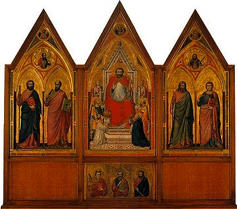


.... and, not always everybody pays attention to the ceremony .... but find the time for making a selfie. After all, those are the full-professionals.

Maybe, this is also the way we have to read this part of the triptych: The sponsor (Card. Stefaneschi) in the front on his knees before St.Peter on the throne. You can imagine the chatting with his colleages during the ceremonies: "Can you see there the man in white on the front? ... That's me! Yes I paid for it. For thé Saint Peter's Basilique!" ... "Who made it ?" ... "Giotto" ..."no, thé famous Giotto ?!, the most important painter of our time?" ... "O Yes, but for the Saint Peter's Basilique only the best is good enough .... and... maybe after this gift I will get my promotion that is long overdue !"
Remarkable is that the perspective is not respected, just like in many other works that surround us in those first rooms... as you also will see in many paintings on the wall. Those works of art also representing the perfect society as described by Plato in his "Republic" or the "Divine City-Civitas Dei" by saint Augustine. In the late medieval they wanted to keep the perfect feodal order of the past: A society divided in three classes: the lowest is the working class, above them stands the military force and the nobility, and on top we have the ecclesiastical hierarchy. The Concordate of Worms of 1122 puts the autorithy of the popes above that of the emperor. It was the end of the batlle of the investiture: who can nominate who. The sacred authority (with miter, ring and staf) proceeds the secular autorithy (with the lance) and that proceeds the lower cast of farmers and citizens.(read here the full text)
This kind of society is reflected in the arts of that time: A layman will be always smaller than a soldier; a soldier smaller than a priest; a priest smaller than a bishop; a bishop smaller than a saint; a saint smaller than the Lord. No matter were you are raffigurated on the painting: Through art they will tell you exactly what your position is in the world. Starting from an idea (Plato) how the society should be, the painting shows us the social order of it's time.

The retro has for sure more spirituality: On the leftside between two piramides (the Cestio one in Rome, the other was near the Vatican but destroyed over the history), we have the martyrdom of saint Peter on the cross, and on the right hand side, the martyrdom of saint Paul with the sword. (a privilege for those who were roman citizens)
Room 3: Beato Angelico & Filippo Lippi
And we come back to Rome; After their return from Avignon in 1378, the popes decided to live within the walls of the Vatican, and not anymore in the complex of Saint John in Lateran. The city was also in a deplorable state. Only approx 25 000 inhabitants, no water-supply of the Roman acquaducts anymore. So, living on the hill of St. John was excluded, at least the Vatican City was close to the Tiber. In Avignon, we have seen how much money was involved in the papacy; Have just a look at what the popes manage to build in only 70years!
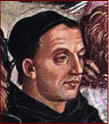
Beato Angelico, Luca Signorelli, Orvieto Cathedral - 1501


The money used in Avignon came back to Rome. The best artist of the Tuscan School gathered together to build and decorating the new residence of the Popes.
Fra Angelico,( born 1395°- 1455 Guido di Pietro), became the favorite for pope Nicolas V. He is buried in the church behind the Pantheon: Santa Maria sopra Minerva. (see pictures)
"But it is impossible to bestow too much praise on this holy father, who was so humble and modest in all that he did and said and whose pictures were painted with such facility and piety." (Vasari, Lives of the Most Excellent Painters, Sculptors, and Architects)
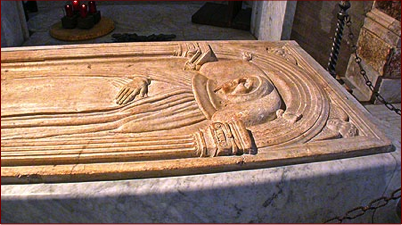

Avignon
In the apostolic palace he painted the most marveleous works for Pope Nicolas V: the famous Niccoline Chapel. In his corrupt world he was a priest of outstanding qualities. The following story is told by Vasari ....
Seeing that Fra Giovanni was a most holy, peaceful, and humble minded man (as in very
deed he was) the Pontiff thought this simple Monk worthy to fill the archiepiscopal chair of
Florence, which happened at that time to be vacant; but upon its being offered to him, Fra
Giovanni intreated his Holiness that this dignity might be bestowed upon some other person,
in as much as he did not consider himself fit to hold rule over men; and he pointed out a
Monk of his Order, who loved the poor, was most learned, and capable of governing, and
upon whom that high office might be conferred much more fitly than upon himself. Hearing
this, and being aware of its truth, the Pope most freely granted the request, and it was thus that
the Dominican monk Antonino came to be Archbishop of Florence, a man famous for his
sanctity and his learning, and, in a word, such as to deserve to be canonized by Adrian VI.
now in our own times. Great was the goodness of Fra Giovanni (indeed most rare in these
days) to yield so great a dignity and honour, offered to him by the Pontiff, to another man,
whom with gladness and singleness of heart he thought more fit for them than himself. Let the
Ecclesiastics of our times learn from this holy man not to seek greedily those honours which
they can not worthily sustain, but rather to yield them to the more deserving. But to return to
Fra Giovanni; would to God that every Ecclesiastic (and the Faithful ought to take this in
good part) spent his time, as did this truly angelic Monk, in the service of God, and to the good of his neighbour and of the world! What more can any one desire, what more ought anynone to desire, than by holy living to gain the Heavenly Kingdom,
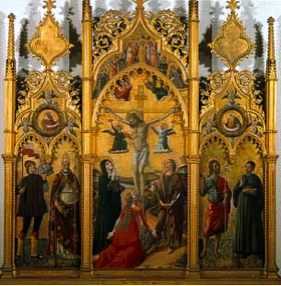

In the text, Vasari admires the virtues of Fra Angelico, a man non to seek greedily honours and power. This is the time of the schism, and the pope made a lot of money by selling ecclesiastical honours and indulgencies.
Of course, you have to convince the people to buy their heaven. The Divine Comedy of Dante Alighieri with heaven, hell and pulgatory, depicted the afterworld as a real world. Heaven would be a place were everything would be perfect.
Overholly Madonnas are a consequence of it. Wouldn't you like to buy your heaven were you can eat rice with golden spoons? Espescially in a world were nobody knew if he would be alive the very next day: famine and plague conquered Europe and in a few years about 25 million people died from one day to another.
Therefore there were movenments of pietism and in sermons people were warned about the terrible fate that waited them in hell, or ... at their own decision, making a choice for the benefits of heaven.
The idea is that heaven is a place were everything would be perfect, and that idea is reflected in the paintings: Madonna's after retouching with face-lifts ...
Simultaneous there were also movements that wanted a total different church, a church of the people.
The book of Umberto Eco "In the name of the Rose" we are seeing an heretic movement, the Waldensians (founded by Peter Waldo in Lyon), who refuse the in the 14th century the authority of the pope and want to live the poverty of Christ like Saint Francis. the harsh reaction of the church was the inquisition, runnend by the Domenican fathers from which Beato Angelico was member.
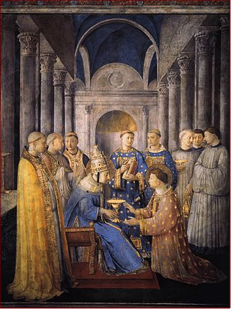
St Peter consacrates saint Laurence deacon, Private chapel Pope Nicolas V
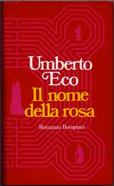
Room 5: Melozzo da Forli (1438-1494)
Some painters suddenly made total different kind of works: instead of over-holy people, suddenly we see real people: Melozzi da Forli's figures are looking so human. An expression of those who want a church not ruled from above (the hierarchy and the Vatican), but a church of comon people, a poor church as St. Francis wanted.
The angels of Melozzo da Forli could be people we know .... and thus, salvation is also possible for us. Heaven is not impossible.
Those beautiful frescoes were originally made for the Church Santissimi Apostoli near the Piazza Venezia. Luckely they were rescued before the decoration of the Church was altered.
From and idealic world (Plato) where heaven is an Utopia, we have now a heaven of real people (Aristotle)

Pietà of Michelangelo
Famous is also his frescoe where pope Sixtus IV appoints Bartolomeo Platina prefect of the Vatican Library in 1475. The world is about to change. Plotina kneeling in front of the pontif and in front of Pope Sixtus IV (who build the Sistine Chapel) is standing his nephew, the future pope Julius II.


Room 6:
After this room, we will see how arts are changing dramatically. But also the world had changed. New discoveries in science, printing, and even America was discovered.
Still, in the last decades of the 15th century, artists started from idea's instead of the reality. In the Triptych on the right, we see Jesus on the cross, surrounded by Mary, st. John and on his feet, on her knees, st Mary Magdalen. I can't immagine that they would stand in those position when Jesus was dying: St. John with open mouth, Mary with folded hands, and ... what is doing Mary Magdalen??
In the musical "Jesus Christ, Superstar"

Wasn't she the prostitute from which people spoke scandal that Jesus met her? But the painter received the order to paint the following subject: "Jesus died on the cross for us, sinners." After reading the bible, he must have closed his eyes and came up with this result.
In the triptych, Mary Magdalen is repeating her act of conversion. When She met the Lord for the first time, with her tears, she wet his feet, with her beautiful hair she dried His feet, and with expensive oinments she balsemed His feet. The red color of her dress expresses the immense love she had for Him. She is the model of the converted. Since 2016 she became enlisted among the official saints with proper feast to celebrate.
And this is exactly what happened here: He died on the cross, so that we -sinners- can live.
This Room is closing an era, and therefore , I want to make a little excursions about the use of light/gold in the arts we have seen until here. In the next room, with the Umbrian School of Perugino, we will see that all the gilding is disappearing.
For more understanding of the use of gold-leaves, symbol for the light of the first day, the horns of Moses and much more, go to my webpage: "The horns of Moses" and the use of light in Arts.

Follow the link for Part II of the Pinacoteca del Vaticano: from the 16th century until the 19th century, and we start with Perugino, the teacher of Raphael

Moses at the Column of the Immaculate conception on Piazza di Spagna
Listen to music from 1300-50
Click on images
Listen to the music of 1480-1500, click on image





The serial of little paintings we have here is in my eyes the most beautiful expression of the works of Mercy I have ever seen. (they are on the right hand wall, just before entering room 3). Usually, the saint has the halo ... he is the one who became Saint by doing one of the seven good deeds. Grace vs. works has been a debate for centuries. It’s not surprising that man feels compelled to earn salvation on the basis of works, not by grace. The Council of Trent on Justification (Canon 12) states: “If anyone says that justifying faith is nothing else than confidence in divine mercy [grace], which remits sins for Christ's sake, or that it is this confidence [faith] alone that justifies us, let him be anathema [cursed]”. In these little works the world is turned upside down: the beneficiary of the good works has the halo, not the one who is doing the good works! Didn't Christ say: "‘Truly I tell you, whatever you did for one of the least of these brothers and sisters of mine, you did for me.’ (Matt. 25:31-46)
Look how the homeless, the hungry, the thirsty, the naked, the sick, the prisoner and the dead have the halo ...
A Holy Year of Mercy ... 2016
L'Alunno, Crocifissione tra i SS.Venanzio, Pietro, Giovanni Battista e Porfirio (Trittico di Camerino)
M

Below: Altar dorsal with The Works of Mercy, Olivuccio di Ciccarello, Ancona, 1388-1439